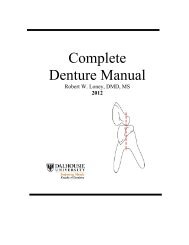RPD Manual 11 - Removable Prosthodontics - Dalhousie University
RPD Manual 11 - Removable Prosthodontics - Dalhousie University
RPD Manual 11 - Removable Prosthodontics - Dalhousie University
You also want an ePaper? Increase the reach of your titles
YUMPU automatically turns print PDFs into web optimized ePapers that Google loves.
Denture Bases - 60<br />
Advantages:<br />
Beaded metal base for single tooth replacement<br />
Metal filled edentulous space Retentive posts<br />
can be particularly useful<br />
in anterior regions<br />
1. Thermal Conductivity - Thermal conductivity is thought to maintain tissue health by<br />
ensuring patients do not swallow substances that are too hot. Some patients feel that<br />
improved thermal perception lessens the feeling of the denture as a foreign object.<br />
2. Accuracy and Permanence of Form - Metal alloys cast accurately and maintain their<br />
accuracy. The accuracy in casting can eliminate the need for a posterior palatal seal. In<br />
contrast, acrylic resins distort due to release of internal strains after processing. This causes<br />
them to distort away from palate in the posterior region, thereby affecting retention. In<br />
addition, acrylic resins can imbibe or lose moisture depending on their storage conditions,<br />
leading to distortion and/or warpage if they are improperly stored. Abrasion from tooth<br />
brushing can adversely affect retention of acrylic resin bases in extreme cases.<br />
3. Hygiene - Metal surfaces are less porous than resin surfaces. This lessens food, plaque and<br />
calculus accumulation, thereby maintaining healthy tissues.<br />
4. Weight and Bulk - The metal bases can be cast thinner than resin bases while maintaining<br />
adequate strength. Thus, metal bases have minimal weight and bulk.<br />
Flange Extension<br />
1. Denture bases for tooth-tissue supported partial dentures (Class I and II) should be extended<br />
to provide the greatest available surface area for support and retention, without overextension<br />
or impingement on movable border tissues.<br />
2. Tooth supported partial dentures (Class III and IV) need not necessarily be extended<br />
maximally, since most of the support for these dentures comes from the teeth.<br />
3. Maxillary distal extension denture bases should terminate in the hamular notches.















